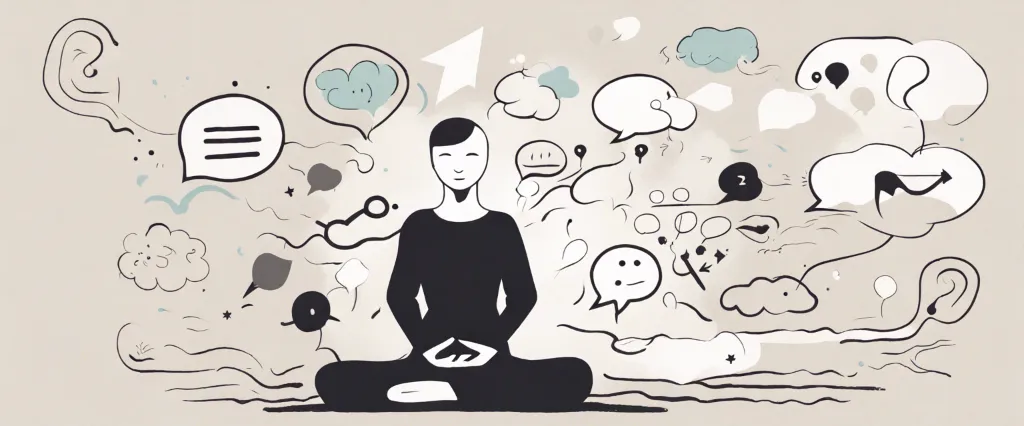In “Mindfulness for Beginners,” Jon Kabat-Zinn invites readers into the transformative practice of mindfulness, offering a gentle yet powerful guide for those who seek to cultivate resilience, presence, and inner peace. As an acclaimed mindfulness teacher, scientist, and founder of the renowned Mindfulness-Based Stress Reduction program, Kabat-Zinn has dedicated his life to integrating mindfulness into modern healthcare and society. With his wealth of experience and expertise, he welcomes readers on a journey to discover the profound benefits of mindfulness and how it can be harnessed in our daily lives.
Chapter 1: Introduction to Mindfulness
In Chapter 1 of the book Mindfulness for Beginners by Jon Kabat-Zinn, the author introduces the concept of mindfulness and its significance in our lives. Kabat-Zinn defines mindfulness as the practice of paying attention in the present moment, intentionally and non-judgmentally. He emphasizes that mindfulness is not a religious or philosophical concept, but rather a universal quality of human consciousness that can be cultivated and applied to enhance well-being.
The author highlights the importance of mindfulness in our daily lives, pointing out that most of us are caught up in a so-called “automatic pilot” mode, where we perform tasks mindlessly, allowing our thoughts to wander and our emotions to take control. By practicing mindfulness, we can break free from this state and start living with greater awareness, intention, and clarity.
Kabat-Zinn presents mindfulness as a life skill that can help us cope with stress, pain, and anxiety more effectively. By staying present in the moment, we can observe our thoughts and emotions without reacting immediately, allowing us to respond more mindfully rather than being driven by automatic, impulsive reactions.
Moreover, the author explains how mindfulness is a state that can be cultivated through meditation and various everyday activities such as eating or walking. Kabat-Zinn encourages readers to embark on their mindfulness journey by committing to a sustained practice, as cultivating mindfulness requires patience, discipline, and regularity.
In conclusion, Chapter 1 serves as an introduction to the concept of mindfulness, highlighting its relevance in our lives and emphasizing its potential to enhance well-being. By practicing mindfulness, individuals can develop a greater sense of awareness, purpose, and resilience in order to navigate life’s challenges with increased clarity and calmness.
Chapter 2: Cultivating Awareness of the Present Moment
Chapter 2 of “Mindfulness for Beginners” by Jon Kabat-Zinn focuses on cultivating awareness of the present moment. The author emphasizes the importance of being fully present in each moment and developing a conscious relationship with our experiences.
Kabat-Zinn introduces the concept of the “autopilot,” which refers to our tendency to carry out daily tasks without truly paying attention to them. He encourages readers to break free from this automatic mode of functioning and instead engage with their surroundings deliberately. By doing so, individuals can become more attuned to their senses, thoughts, and emotions, fostering a greater sense of mindfulness.
The author introduces formal mindfulness practices, such as mindfulness meditation, as tools for cultivating awareness. He emphasizes the significance of sitting in a quiet and calm space, focusing on the breath, and observing thoughts and bodily sensations without judgment. Through regular practice, individuals can develop a heightened sense of awareness, allowing them to better comprehend the present moment.
Kabat-Zinn also discusses the importance of mindfulness in everyday activities, referring to it as informal practice. He suggests integrating mindfulness into daily routines, such as eating, walking, and listening, by fully engaging the senses and being fully present for these experiences.
Throughout the chapter, the author highlights the potential benefits of mindfulness, such as reduced stress, enhanced well-being, and improved mental clarity. He emphasizes that the practice of mindfulness extends beyond the meditation cushion and into all aspects of life, enabling individuals to experience a profound sense of connection with themselves and the world around them.
In summary, Chapter 2 of “Mindfulness for Beginners” guides readers in cultivating awareness of the present moment through formal and informal mindfulness practices. It teaches individuals how to break free from automatic functioning, develop a conscious relationship with their experiences, and embrace mindfulness as a way of life.
Chapter 3: The Power of Breath: Mindful Breathing Practices
Chapter 3: The Power of Breath: Mindful Breathing Practices explores the significance of breath and introduces various mindful breathing techniques in the book Mindfulness for Beginners by Jon Kabat-Zinn. The chapter emphasizes the crucial role that breath plays as an anchor to the present moment and a tool for cultivating mindfulness.
Kabat-Zinn begins by emphasizing the importance of paying attention to the breath, as it is always available to us and a constant reminder of being alive. He highlights how intentional breathing can have a profound effect on our state of mind and overall well-being. By acknowledging and observing the breath, we can bring ourselves back to the present moment and break free from the distractions and complexities of the mind.
The chapter introduces three primary practices: the mindful breathing anchor, the body scan, and the full catastrophe breath awareness. The mindful breathing anchor involves focusing one’s attention solely on the sensation of breath, training the mind to stay present. Meanwhile, the body scan involves systematically directing one’s attention to different body parts, observing any sensations without judgment. Finally, the full catastrophe breath awareness allows for deeper exploration of breath and invites a more encompassing awareness of bodily sensations.
Throughout the chapter, Kabat-Zinn explains the intricate relationship between breath, thoughts, and emotions. He encourages readers to approach their breath without imposing any expectations or judgments. By fully accepting the breath in its natural state, individuals can develop a deep understanding of their inner experiences and cultivate a sense of calm and clarity.
Overall, Chapter 3 emphasizes the transformative power and accessibility of breath as a vital tool for developing mindfulness. Through the various breathing practices introduced, readers are encouraged to integrate breath awareness into their daily lives, ultimately enhancing their ability to live fully in the present moment.
Chapter 4: Body Scan: Exploring Sensations in the Body

Chapter 4 of “Mindfulness for Beginners” by Jon Kabat-Zinn is titled “Body Scan: Exploring Sensations in the Body” and focuses on the practice of body scanning as a means of developing mindfulness.
The chapter begins by explaining that our bodies constantly provide us with a wealth of information, but we are often not fully aware of the sensations we experience. Kabat-Zinn introduces the body scan as an exercise to bring attention to the physical sensations in each part of the body, from head to toe, in a systematic and non-judgmental way.
He describes the body scan practice as a form of meditation, emphasizing the importance of approaching it with an open and curious attitude. The body scan involves mentally scanning each part of the body, starting from the head and moving down to the toes. While doing so, one pays attention to the physical sensations present in each part, without analyzing or reacting to them.
Kabat-Zinn highlights the potential benefits of the body scan, such as developing a deeper connection with the body, recognizing patterns of tension or discomfort, and learning to cultivate a sense of compassion towards oneself. He also reminds readers that the body scan may bring up challenging emotions or sensations, and encourages them to approach these experiences with kindness and curiosity.
The chapter concludes with a guided body scan exercise, providing readers with a practical experience of the practice. Overall, Kabat-Zinn emphasizes the body scan as a valuable tool for cultivating mindfulness and developing a deeper understanding and appreciation of the body.
Chapter 5: Mindful Eating: Nurturing a Healthy Relationship with Food
In Chapter 5 of “Mindfulness for Beginners” by Jon Kabat-Zinn, titled “Mindful Eating: Nurturing a Healthy Relationship with Food,” the author explores the concept of mindful eating and emphasizes the importance of developing a healthy and mindful relationship with food.
Kabat-Zinn begins by acknowledging the fast-paced and stressful nature of modern life, which often leads to people eating mindlessly, rushing through their meals, or even multitasking while eating. He highlights that this approach disconnects us from the sensory experience of eating, leading to overeating and various health problems.
The chapter emphasizes the practice of mindfulness while eating, encouraging readers to pay full attention to the process of eating and savoring each bite. Kabat-Zinn encourages us to cultivate awareness of the colors, textures, smells, and flavors of the food, as well as the bodily sensations and emotions that arise during the act of eating. By doing so, we can better understand our body’s hunger and satiety signals and make healthier eating choices.
Furthermore, the chapter discusses the impact of mindful eating on weight management and weight loss goals. Kabat-Zinn highlights that mindful eating helps develop a natural regulatory system within the body, allowing it to find a healthy balance and prevent overeating.
The author provides practical suggestions and exercises for incorporating mindful eating into our daily lives. For example, he recommends eating at a designated dining area, without distractions, and taking time to fully appreciate and enjoy each bite.
In summary, Chapter 5 of “Mindfulness for Beginners” emphasizes the practice of mindful eating and its role in developing a healthy and balanced relationship with food. By cultivating awareness and paying attention to the sensory experience of eating, readers can make more informed choices, prevent overeating, and develop a healthier overall lifestyle.
Chapter 6: Embracing Difficult Emotions with Mindfulness
Chapter 6 of “Mindfulness for Beginners” by Jon Kabat-Zinn is titled “Embracing Difficult Emotions with Mindfulness.” In this chapter, Kabat-Zinn explores how mindfulness can help individuals navigate and embrace difficult emotions rather than trying to avoid or suppress them.
The chapter begins by emphasizing the importance of acknowledging and accepting our emotions, even the challenging ones. He highlights that mindfulness is not about getting rid of or changing our emotions but rather about relating to them in a different way. Mindfulness encourages us to develop a compassionate and non-judgmental attitude towards our emotions, allowing them to arise and pass away naturally.
Kabat-Zinn explains that by practicing mindfulness, we can develop the ability to observe our emotions without getting caught up in them. Rather than identifying with the emotion and becoming overwhelmed, mindfulness enables us to observe its physical sensations and thoughts without judgment. This allows us to develop a spacious awareness and let the emotion be as it is, ultimately creating a sense of freedom and calm amidst difficult emotions.
The author also emphasizes that difficult emotions can serve as teachers, providing valuable insights about ourselves and our lives. Mindfulness allows us to investigate these emotions and understand their underlying causes. By approaching difficult emotions with curiosity and openness, we can gain wisdom and develop a clearer understanding of ourselves.
In summary, Chapter 6 explores how mindfulness can help us embrace challenging emotions. By practicing non-judgmental observation, acceptance, and curiosity towards our emotions, we can develop a more empowered and compassionate relationship with them. Through mindfulness, we learn to relate to difficult emotions in a way that allows them to naturally arise, pass away, and even provide valuable insights into our inner world.
Chapter 7: Mindful Communication: Enhancing Relationships
Chapter 7 of “Mindfulness for Beginners” by Jon Kabat-Zinn focuses on the practice of mindful communication and how it can enhance relationships. Kabat-Zinn emphasizes the importance of being fully present and attentive during conversations, allowing for a deeper understanding and connection with others.
The chapter introduces the concept of “mindful listening,” which involves giving our full attention to the speaker without interrupting or judging their words. Kabat-Zinn suggests that this practice can help us develop empathy, as we genuinely understand and acknowledge the other person’s perspective. He encourages us to let go of preconceived ideas and assumptions, opening ourselves up to truly hearing what the other person is saying.
Furthermore, Kabat-Zinn emphasizes the significance of self-awareness during communication. By being mindful of our own thoughts, emotions, and reactions, we can prevent automatic, unhelpful responses and instead choose more thoughtful and compassionate replies. This self-awareness allows us to communicate more harmoniously and effectively, avoiding unnecessary conflict.
The chapter also emphasizes the power of nonverbal communication and body language in relationships. Kabat-Zinn suggests that we pay attention to our own nonverbal cues and cultivate a presence that conveys openness, trust, and understanding. By being mindful of our body language, we can foster an environment of safety and receptivity for effective communication.
In conclusion, Kabat-Zinn highlights the transformative potential of mindful communication in nurturing and deepening relationships. By cultivating active listening, self-awareness, and nonverbal cues, we can create a space for genuine understanding and connection with others. This chapter serves as a guide to communicate mindfully, enabling us to enhance our relationships and build stronger connections with those around us.

Chapter 8: Integrating Mindfulness into Daily Life
Chapter 8 of “Mindfulness for Beginners” by Jon Kabat-Zinn focuses on the integration of mindfulness into our daily lives. Kabat-Zinn emphasizes that mindfulness should not only be practiced during formal meditation sessions but should be applied in every aspect of our lives for it to become truly transformative.
One key aspect discussed in this chapter is the importance of present moment awareness. Kabat-Zinn explains that we often get caught up in the past or future, leading to a lack of presence in our daily experiences. By cultivating mindfulness, we can fully engage with the here and now, appreciating and fully experiencing each moment.
Additionally, the chapter highlights the significance of intention and attention. Kabat-Zinn suggests that we set intentions for how we want to show up in the world and then direct our attention towards these intentions. By being mindful of our thoughts, emotions, and actions, we can effectively respond to situations with more clarity and compassion.
Kabat-Zinn also explores the concept of mindfulness while engaging in daily activities such as eating, walking, and even brushing our teeth. He encourages readers to bring mindful awareness to these seemingly mundane tasks, allowing us to connect with our senses and fully experience the present moment.
Moreover, the chapter delves into the power of mindful communication and relationship-building. Kabat-Zinn emphasizes the importance of listening fully, speaking mindfully, and being present with others, fostering authenticity, understanding, and deep connection.
In conclusion, Chapter 8 of “Mindfulness for Beginners” emphasizes the integration of mindfulness into daily life. Kabat-Zinn highlights the significance of present moment awareness, intention, attention, engaging in daily activities mindfully, and fostering meaningful connections with others. By incorporating mindfulness into all aspects of our lives, we can cultivate a greater sense of fulfillment, peace, and joy.
After Reading
In conclusion, “Mindfulness for Beginners” by Jon Kabat-Zinn is a comprehensive and practical guide for individuals seeking to incorporate mindfulness into their lives. The book focuses on the importance of living in the present moment and harnessing the power of awareness to reduce stress, improve overall well-being, and cultivate a deeper sense of peace. Kabat-Zinn shares a wealth of insightful anecdotes, exercises, and meditations that gently guide readers through the process of developing mindfulness skills. His emphasis on non-judgment and compassion while practicing mindfulness adds a refreshing and compassionate approach to this ancient practice. Overall, “Mindfulness for Beginners” is a valuable resource for anyone wanting to explore mindfulness and its potential to transform their lives for the better.
1. The Power of Now” by Eckhart Tolle: This bestselling book provides practical advice on how to live in the present moment and cultivate mindfulness. Tolle’s teachings help readers understand the importance of mindfulness in finding inner peace and attaining happiness.
2. “Wherever You Go, There You Are” by Jon Kabat-Zinn: Another book by Jon Kabat-Zinn, this work explores the benefits and techniques of mindfulness meditation in everyday life. It offers a simple and inspiring introduction to mindfulness, encouraging readers to bring awareness into every aspect of their lives.
3. A New Earth: Awakening to Your Life’s Purpose” by Eckhart Tolle: In this transformative book, Tolle explores how embracing mindfulness and being present can help individuals find their life’s purpose. Written with clarity and wisdom, it guides readers towards a deeper understanding of themselves and their place in the world.
4. “Full Catastrophe Living” by Jon Kabat-Zinn: This comprehensive guidebook delves deeper into the principles of mindfulness as a way to cope with stress, pain, and illness. Kabat-Zinn presents practical exercises and strategies for integrating mindfulness into everyday life, helping readers thrive in the face of life’s challenges.
5. “The Miracle of Mindfulness” by Thich Nhat Hanh: Written by renowned Buddhist monk Thich Nhat Hanh, this timeless classic introduces readers to the practice of mindfulness in a simple yet profound way. Hanh provides insightful stories, exercises, and meditations that guide readers towards developing a deeper awareness and appreciation for each moment.




